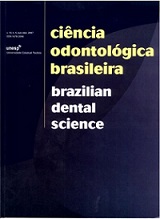Water interaction with dental luting cements by means of sorption and solubility
DOI:
https://doi.org/10.14295/bds.2012.v15i4.826Resumo
Water contributes to the setting reaction of self-adhesive luting cements, however, it can also accelerate their degradation. Objectives: The aim of this study was to compare a self-adhesive resin luting cement to other resin-based and glass-ionomer luting materials with regards to water sorption (WS) and solubility (WSB). The tested null hypothesis was that there is no difference in respect to these properties among the materials. Material and methods: Eight specimens from each group (15 mm x 0.5 mm) were prepared from self-adhesive luting cements Biscem (BC) and RelyX Unicem (R), dual-cure cements Bifix (BF), Allcem (A) and Enforce (E), chemical-cure cements C&B (CB) and Cement Post (CP) and a glass-ionomer luting cement Meron C (M) as the control group. The dual-cure products were light-cured beneath an IPS Empress Esthetic ceramic disk (20 mm x 1.5 mm) and for the chemical reaction materials, a 15 min-interval was respected for removal from the mould. The WS and WSB were respectively calculated as (m2-m3/V) and (m1-m3/V). Mass values of m1, m2 and m3 were determined by cycles of desiccation, water-immersion and a new desiccation. For each property, the data was analyzed by one-criteria ANOVA and Tukey tests (p < 0.05). Results: The glass-ionomer cement presented the highest WS, followed by the self-adhesive luting cements. Other resin cements were less susceptible to WS. No materials differed from each other when the WSB was considered, except for the M, which presented the lowest WSB. Conclusions: Self-adhesive luting cements were more prone to WS since water is essential to their setting reaction. However, their WSB was similar to the other resin-based cements.
Downloads
Downloads
Arquivos adicionais
Publicado
Como Citar
Edição
Seção
Licença
TRANSFERÊNCIA DE DIREITOS AUTORAIS E DECLARAÇÃO DE RESPONSABILIDADE
Toda a propriedade de direitos autorais do artigo "____________________________________________________________________" é transferido do autor(es) para a CIÊNCIA ODONTOLÓGICA BRASILEIRA, no caso do trabalho ser publicado. O artigo não foi publicado em outro lugar e não foi submetido simultaneamente para publicação em outra revista.
Vimos por meio deste, atestar que trabalho é original e não apresenta dados manipulados, fraude ou plágio. Fizemos contribuição científica significativa para o estudo e estamos cientes dos dados apresentados e de acordo com a versão final do artigo. Assumimos total responsabilidade pelos aspectos éticos do estudo.
Este texto deve ser impresso e assinado por todos os autores. A versão digitalizada deverá ser apresentada como arquivo suplementar durante o processo de submissão.




























